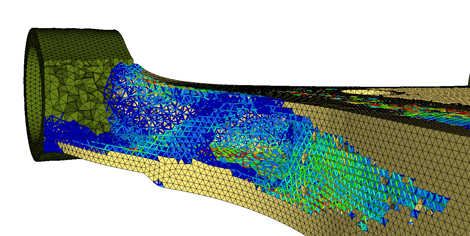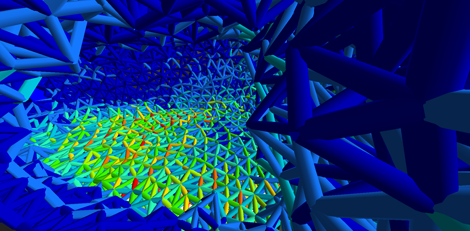
Optistruct is aiming at the high-end 3D printing market with its topology and optimisation tools
With new solver capabilities, Altair’s OptiStruct topology optimisation software is aiming at the high-end 3D printing market to help print the most optimal and structurally efficient products.
Its eye-catching capabilities for 3D printing lie in its ability to manufacture hollow shapes with complex external geometry using tiny cells known as lattice structures.
OptiStruct now extends topology optimisation to assist in the efficient blending of solid-lattice structures with smooth transitional material volume, while lattice performance can be studied under tension, compression, shear, flexion, torsion, and fatigue life.

Altair is working with partners like Materialise to enable more efficient data transfer for 3D printing
“3D printing brings new structural freedom to product design, allowing more complexity in shapes and topology and the efficient production of customized products while accelerating the manufacturing process, since no tooling is needed,” said Altair chief technical officer Uwe Schramm.
“Topology optimisation maximises this design freedom, enabling complex free-form structure development, seamless individual designs, a shorter design process, and optimal 3D-printed structures.”
Altair is working with partners like Materialise to enable more efficient data transfer for 3D printing.
Lattice structures may contain hundreds of thousands of lattice cells, so the conventional STL file transfer can be a significant bottleneck for the overall process.
Software packages like Materialise 3-MaticSTL focus on improvements of a given lattice component to accommodate the various requirements of the 3D printing process, creating support structures where necessary.
In contrast to technologies that simply apply lattice structures to existing geometry, the OptiStruct software looks to enable the designer to identify the best material placement and lattice structures. Optimisation identifies where material is needed in a design and where it is not required, prior to placing and optimising the lattice.
OptiStruct works in two phases: First, it applies standard topology optimisation, allowing more porous materials with intermediate densities to exist. Next, the porous zones are transformed into explicit lattice structures with varying material volume.
In the second phase, the dimensions of the lattice cells are optimised, resulting in a structure with solid parts plus lattice zones with varying volumes of material.
There is a relationship to be explored between material density and part performance, for example with respect to the stiffness to volume ratio, that can impact design choices made early in the product development process.
Porosity may be especially important as a functional requirement for biomedical implants. Lattice zones could be critical to the successful development of products where more than mere stiffness is required.
Some applications may need to consider buckling behavior, thermal performance, dynamic characteristics, and other aspects, all of which can be optimised.
With OptiStruct, users may manipulate material density based upon the result of the optimisation process, comparing stronger versus weaker, or solid versus void versus lattice, designs. The designer first defines the objective, then performs analysis to inform the design.
“OptiStruct’s lattice capability represents the first step towards integrating smart materials with unique properties in products,” said Ming Zhou, VP of software development at Altair.
“Continuing research and development will explore directional behaviour and smooth blending of varying lattice cell layouts to take advantage of exotic material characteristics that could bring innovation to various applications.”






